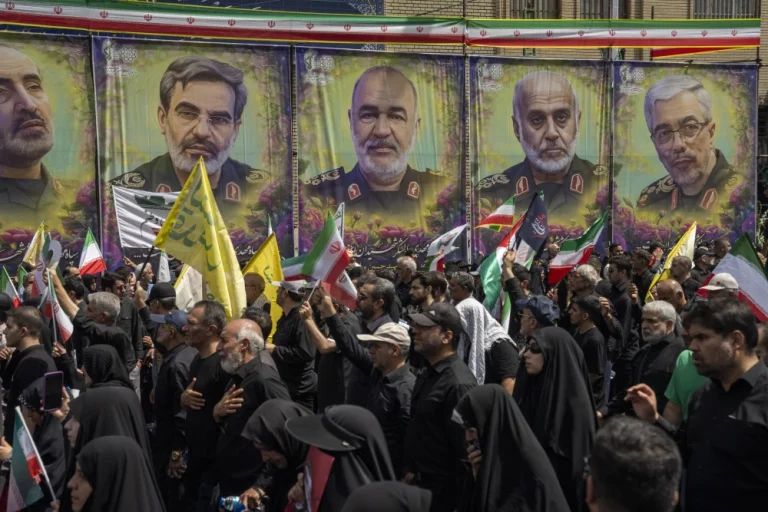Iran Holds Massive Funeral for Senior Commanders and Scientists Killed in War with Israel
Thousands of Iranians dressed in black gathered in the heart of Tehran on Saturday for a solemn funeral procession honoring military leaders, nuclear scientists, and civilians killed during this month’s war with Israel.
State media reported that among the 60 individuals being commemorated were at least 10 top commanders and 16 nuclear scientists, including some of the country’s most senior figures. Those killed included Major General Mohammad Bagheri, chief of the armed forces, Islamic Revolutionary Guard Corps (IRGC) Commander General Hossein Salami, and General Amir Ali Hajizadeh, head of the IRGC Aerospace Force.
The coffins, draped in Iranian flags and adorned with portraits of the deceased, were paraded through Azadi Square. Mourners waved national flags, chanted slogans, and threw rose petals as the vehicles carrying the remains passed by. Iranian state TV aired footage showing large displays of ballistic missiles, underscoring the military aspect of the event.
Mass prayers were held at the square following the procession, in a ceremony referred to by state media as the “Martyrs of Power” funeral. Among the dead were also four women and four children, according to official reports.
President Masoud Pezeshkian and other high-ranking officials, including Supreme Leader Ayatollah Ali Khamenei’s adviser Ali Shamkhani—who was reportedly wounded during the fighting—attended the ceremony. Khamenei’s son Mojtaba also made a rare public appearance.
Foreign Minister Abbas Araqchi, writing on Telegram, praised the nation’s response to the conflict: “The Iranian people have stood firm against two nuclear-armed regimes, preserving their pride and sovereignty. Our resolve has only grown stronger.”
Khamenei himself has not been seen in public since the war began, and did not release a statement regarding the funeral. In previous conflicts, he has led prayers at funerals for senior military figures, but on this occasion, only pre-recorded messages have been broadcast.
The conflict erupted on June 13 when Israeli forces launched coordinated airstrikes on Iranian nuclear facilities and military targets, killing several high-profile figures, including Bagheri, Salami, and Hajizadeh on the first day of attacks. Iran responded with a barrage of missiles aimed at Israeli cities and strategic installations.
The United States entered the conflict on June 22, launching its own strikes against Iranian nuclear infrastructure. Washington claimed the moves were intended to prevent Iran from advancing toward nuclear weapons capability—an accusation Tehran firmly denies. The U.N. International Atomic Energy Agency (IAEA) has stated it has found no solid evidence of an active nuclear weapons program in Iran.
Bagheri was buried Saturday afternoon at Behesht Zahra Cemetery, just outside Tehran. The burials for Salami and Hajizadeh are scheduled for Sunday.
Meanwhile, former U.S. President Donald Trump said Friday he would not rule out future military action against Iran. In response, Khamenei issued a warning via a recorded message, stating that any further U.S. attack would be met with strikes on American bases in the region.
An Israeli military spokesperson described the campaign as a decisive hit on Iran’s nuclear ambitions, though Iranian officials claim otherwise. A statement from the IRGC on Saturday declared that Israel and the U.S. had “failed to accomplish their strategic goals.”
Casualty reports differ significantly: Iran’s health ministry confirmed 610 deaths and more than 4,700 wounded before a ceasefire was declared earlier this week. Human rights group HRANA, however, placed the death toll closer to 974, including 387 civilians. In Israel, the health ministry reported 28 fatalities and 3,238 people injured.

